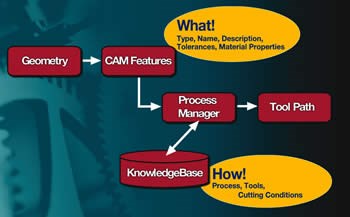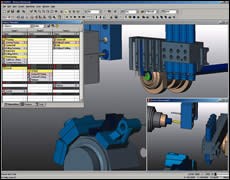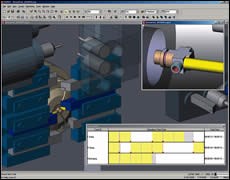Optimizing Cycle Times With CAM
Swiss-type lathes and CNC automatic screw machines now have more power and flexibility and better accuracy than ever. As the popularity of CNC continues to grow on these machines, a good computer-aided manufacturing (CAM) system is increasingly necessary to take full advantage of the machines’ true multitasking capabilities.
Production Machining recently talked with Olivier Thenoz, mill-turn product manager at DP Technology Corp. (Camarillo, California) to discuss the process a shop might go through in integrating CAM and toolpath generation into its environment to help automate the programming process across complex machines. Mr. Thenoz draws from his experience in CAD/CAM applications to provide in-depth answers about what a shop must do to make a successful transition.
DP Technology is the manufacturer of the Esprit CAM system, designed for a range of machine tool applications, including two- to 22-axis turning, two- to five-axis milling, two- to five-axis wire EDM, multitasking mill-turn machining, and B-axis machine tools. Mr. Thenoz has been with the company as a product manager for 4 years. Before that, he spent 5 years in France as an application engineer for CAD/CAM applications.
PM: Mr. Thenoz, what are your views on the progress of CAM integration in the precision machined parts industry?
OT: Screw machine shops were later than most in adopting CAM programming. Swiss-type screw machines were the most recent machines to be equipped with CNCs. This type of production requires highly optimized programs. With the screw machines mainly used for long runs and simple parts, manual programming previously offered more control on the program. It didn’t matter so much to spend a week optimizing a program to shorten the cycle time 1 second if the job was going to run for a year.
In recent years, though, CAM programming has become more flexible, and it provides useful tools for optimizing the cycle time. Also, the machine tools have more power and flexibility. The Esprit programming system supports all the features of the most advanced lathes. It has tools such as a detailed time study to help optimize the program. The graphic interface facilitates balancing of operations and finding the most optimized process. Commonly, CAM programming helps accomplish a shorter cycle time than what could be done manually.
PM: What kind of training would be required for programming a CAM system?
OT: CAM systems are now easy to use. The programmer needs to know the machine and its capabilities, but he doesn’t need to be a computer expert. Initial training usually takes about a week, depending on the machine complexity. Starting the training off-site might be a good way for the students to not be disturbed by their daily tasks. Ending the training by cutting a part on-site is a good way to get confidence in the system.
PM: Who would be a typical candidate for a programming position? Should it be a machinist, operator or computer programmer?
OT: Anyone who’s programming the machine, manually or with a conversational system, would be a perfect candidate to use CAM. Someone who knows the machine and its capabilities is what you should look for. We’re seeing more and more implementation with advanced automation. In that case, anyone could use the software, but a machining expert would still be required to set it up and to improve the process.
PM: What changes might be required to a company’s infrastructure?
OT: A CAM system can fit in many infrastructures, and I’ve seen successful implementation in small companies without the creation of a programming department. However, with highly complex machines like the multitasking Swiss turn, achieving the most optimized programs requires someone with good knowledge of the machine. Successful implementation would require a lead programmer who would be in charge of the organization of libraries and databases available in the CAM system. CAM systems can provide automation on repetitive tasks, but require methodology and organization to save all the data.
PM: How could a shop become more automated?
OT: A first step would be to create custom tool libraries and material and cutting-condition libraries. Then the programmer would save operations and machining strategies.
Advanced CAM systems offer knowledge-based machining (KBM). KBM enables use of predefined processes that auto-adapt to the part geometry. After recognizing machining features on the part, the system will suggest tooling and processes based on previously defined rules. KBM provides a high level of programming automation.
Our software interrogates the solid model and organizes the geometry into features. Next, the programmer can manually associate machining operations to the feature, or he can let the Esprit KnowledgeBase pick the process based on work previously done. As time goes by, the programmer increases and optimizes the machining library based on shop feedback. The knowledge becomes embedded in the software by capturing the best practices.
The more automated the process is, the more time and attention the programmer can focus on higher level tasks, such as optimizing the program or improving the machine productivity.
PM: Can KBM information be transferred from one machine to another, or from one application to another?
OT: The KBM is a database of part types, machining features, processes, tools and cutting conditions. Depending on a part type, the KBM recognizes machining features. These machining features have characteristics that can be dimensional or machining properties. Based on the part type and the feature characteristics, the software automatically retrieves tooling, process and cutting conditions from the database for cutting the part in the most effective way. If the programmer updates a process, this will be updated in the database, refining the machining in a cycle of continuous evolution. The knowledge base improves productivity, quality and consistency, and the positive effects compound as the data grows.
PM: What should be a shop’s ultimate goal for CAM implementation?
OT: The ultimate goal is full automation of the programming. KBM is a good step in this direction. However, the knowledge is not static; it needs machine experts to maintain and update the knowledge and incorporate the latest technologies.
In conjunction with KBM, the Esprit FX technology improves the communication between CAD and CAM software. This bridging technology automatically gets feature information from the CAD system. When importing a part, it reads the geometry of the part along with the CAD features. A hole is not a cylinder; instead it is a tapped hole with a tolerance and a thread depth. These attributes help the KBM to select the best process.
PM: What are the keys to a successful transition when introducing CAM in a shop?
OT: The key to a successful implementation is people: motivated owner, motivated manager and motivated employee. In shops where everybody makes their own programs for the specific machines they are working on, it’s not always easy to implement a CAM system with dedicated programmers. I’ve seen companies training the entire staff on the CAM system, and then those who are the most interested take the lead of programming. Even for someone who will not be using it, knowing the software can help in understanding and accepting the infrastructure changes.
However, mastering the tool requires practice. Because of job urgency, sometimes the programmer prefers using the old tool instead of the newly implemented CAM system. Even if it saves time on the short-term, it is still costly even in the mid-term. Learning curves of today’s CAM systems are pretty quick. When up to speed, gains on cycle time, troubleshooting time and programming time are big. The more diversified the production is, the more programs will be required, and therefore, the more time will be gained using CAM. Short runs are the most profitable with CAM.
PM: Is CAM the essential stepping stone for a company to grow from a mechanical-operation screw machine shop to handling other CNC processes for machining, grinding, EDM, and so on?
OT: The productivity level with multitasking CNC plus CAM is unmatched. New Swiss-lathe machines accept a much broader variety of work. Programmed with good CAM software, the flexibility and the accrued possibilities can open to new types of jobs, such as small-quantity jobs.
We did implementation of automated programming with our software to program milling centers, lathes and multitasking machines, as well as wire EDM machines. It works using the same technology, but the data are of course not the same with EDM technology as with a machine making chips.
PM: What features should a shop look for when selecting a CAM system?
OT: The software is an important factor, just as the machine is. It is important that the software has excellent interoperability with Swiss lathes. The problems a shop faces with Swiss-type lathes are not the same as with a three-axis milling center. Synchronizing the different operations is one of the biggest challenges in Swiss. The programmer needs to balance the operations on the various spindles and turrets in order to reduce dead times and maximize the productivity. Simulation helps to identify opportunities of optimization.
In today’s software the simulation works with the whole machine environment, and a time study helps balance the program. The programmer can drag and drop operations and tools and can easily compare different machining strategies.
Quality of the code output is also something to look for in a CAM system. Previously, a lot of time was required to verify the NC program. Now the programmer spends a few minutes verifying the motions in the realistic 3D simulation, and then the program is sent to the machine with confidence. With little experience, the program works perfectly the first time it runs on the machine. Troubleshooting time on the machine is drastically reduced.
PM: Can you expand on similarities and differences that may exist between programming on lathes and milling centers?
OT: Synchronizing the different operations is a problem specific to Swiss-type lathes and multi-turret machines. These machines can work with two tools (or more) operating simultaneously and moving independently. The programmer would balance the operations on the various spindles and turrets in order to reduce dead times and maximize the productivity.
There are many similarities about programming a lathe and a milling center. The work flow is the same: Import a geometry, recognize features, apply the process, simulate the program, send the program to the machine. Between milling and turning operations, characteristics of the features, process and tooling will be different, but the concept is the same.
In our software the operations manager handles any kind of milling operations (as much as five axes simultaneously) and any kind of turning operations at the same time and with several heads/turrets. We’re very successful programming high-end multitasking machines like Mori Seiki NT or Mazak Integrex machines.
PM: What is DP Technology’s perspective on postprocessors and their significance?
OT: The postprocessor is a key element of the CAM programming. The best tool path is useless if the G code doesn’t accurately reflect this tool path. Esprit is marketed with a pre-packaged solution, which incorporates machining design setup and a high-quality postprocessor. In collaboration with the machine tool builders, we developed preconfigured solutions that have been tested intensively. We also provide the tools to customize the NC output.
PM: How would a shop measure success with CAM?
OT: When running production jobs, the cycle time is the most important factor. CAM systems now offer controls and tools that greatly help in optimizing the cycle time. This is where a shop will notice the results first.
Related Content
Precision Machining Technology Review: August 2024
Production Machining’s August 2024 technology showcase includes some of the latest technology from SW North America, Tsugami, Siemens, Select Manufacturing Technologies, Hurco and ECI Software Solutions — all on display at IMTS 2024.
Read MoreWhat Is Trochoidal Turning? How Might Shops Benefit From It?
While trochoidal milling might be a more well-known toolpath strategy, trochoidal turning can offer similar benefits such as high material removal rates especially for rough-turning operations.
Read MoreKeeping Watch on Small Parts
From watch parts to exotic medical applications, this shop takes on the world of micromachining.
Read MoreWho Are the DFM Consultants? You Are.
Modern shops are bolstering their engineering staff to better offer design for manufacturability advice to their customers. Here, one industry expert suggests ways to develop a common language between manufacturing and engineering.
Read MoreRead Next
Postprocessors: An Integral Part Of Machine Tools
Without a good postprocessor, many machine tools are underutilized. It takes a well-matched post to access the full potential built into a machine.
Read MoreCAM Selection Criteria For Your Swiss-type
Programming complex Swiss-type lathes is simplified with a good CAM purchase. Here are some questions you should ask your vendor.
Read MoreSeeing Automated Workpiece Measurement in Real Time
User-friendly inspection software for CNC machining centers was shown at IMTS 2024 monitoring measurements between and after machining while performing SPC based on recorded measurement values.
Read More















.jpg;maxWidth=300;quality=90)










